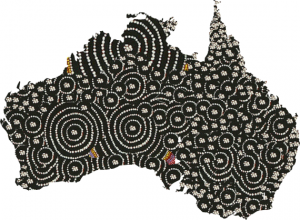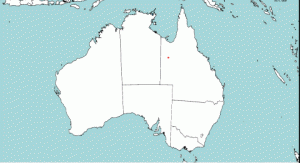
The origin and expansion of Pama-Nyungan
Remco Bouckaert, Claire Bowern and Quentin Atkinson
This website is a quick guide for the media and general public for our paper on Pama-Nyungan origins in Nature Ecology & Evolution. It provides a simplified description of the main research question, the methods and our findings. Experts or others interested in a more detailed and complete description of the study should read the original article…
Pama-Nyungan is the largest hunter-gatherer language family in the world and covers 90% of the Australian continent (by contrast, another 27 language families are packed into a small area in the far north of Australia). How did one group come to dominate almost all of Australia? Where and when did they originate and what might have driven their expansion?
In our recent paper in Nature Ecology & Evolution we combine new data on 306 Pama-Nyungan languages with a set of modelling tools initially developed by epidemiologists to trace the origin of virus outbreaks. We use this approach to infer the root age and homeland of Proto-Pama-Nyungan (the common ancestor of all Pama-Nyungan languages) and trace the family’s expansion through time and space.
This is not the first time these tools have been applied to trace language origins. We have previously applied a similar approach to the origin of the Indo-European language family. We have also previously used computational methods to infer relationships between Pama-Nyungan languages, but never with a temporal and spatial component. The current paper is novel for three reasons: –
1) the subject – compared to the well-studied languages and history of Europe, much less is known about the languages of Australia, their ancestral relationships and the history they reflect. That makes Pama-Nyungan a more challenging family to study, but also potentially more rewarding, as there is so much we do not know.
2) the data – the Chirila dataset is large (much larger than our Indo-European dataset) and reflects 5 years of careful checking and curating by Claire and her team since the previous Pama-Nyungan paper.
3) the models – we have also improved the speed, accuracy and realism of the inference methods in a number of ways. This includes introducing a ‘founder-dispersal’ model of language diversification (in which one lineage migrates while the other stays) and allowing rates to vary based on geographic features, which we used to quantify the effect of proximity to water on migration rates.
In what follows we outline in more detail, the enigma of Pama-Nyungan origins, what we did, what we found, and the wider implications of our work. We also provide some information on linguistic diversity in Australia.
- The enigma of the origin of Pama-Nyungan languages
- What we did
- What we found
- Wider implications
- Preserving linguistic diversity
- Credits
See a visualisation of the Pama Nyungan expansion through time and space…

NB: The lines traced in this visualization do not necessarily indicate the path of migration and simply connect successive populations. Further, whilst our sample represents all known Pama–Nyungan lineages, we cannot make inferences about unattested lineages. The chronology represented here therefore offers a minimum age for Pama-Nyungan expansion into a given area.
